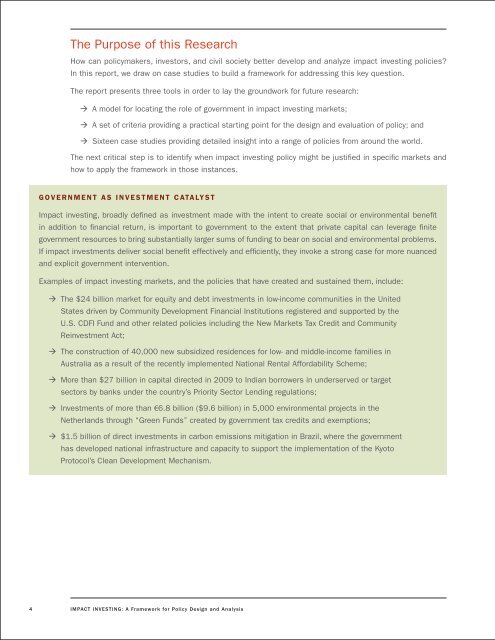IMPACT INVESTING: A Framework for Policy Design and Analysis
IMPACT INVESTING: A Framework for Policy Design and Analysis
IMPACT INVESTING: A Framework for Policy Design and Analysis
You also want an ePaper? Increase the reach of your titles
YUMPU automatically turns print PDFs into web optimized ePapers that Google loves.
4<br />
The Purpose of this Research<br />
How can policymakers, investors, <strong>and</strong> civil society better develop <strong>and</strong> analyze impact investing policies?<br />
In this report, we draw on case studies to build a framework <strong>for</strong> addressing this key question.<br />
The report presents three tools in order to lay the groundwork <strong>for</strong> future research:<br />
‡<br />
‡<br />
‡<br />
A model <strong>for</strong> locating the role of government in impact investing markets;<br />
A set of criteria providing a practical starting point <strong>for</strong> the design <strong>and</strong> evaluation of policy; <strong>and</strong><br />
Sixteen case studies providing detailed insight into a range of policies from around the world.<br />
The next critical step is to identify when impact investing policy might be justified in specific markets <strong>and</strong><br />
how to apply the framework in those instances.<br />
G O VER NMENT AS INVESTMENT CATALYST<br />
Impact investing, broadly defined as investment made with the intent to create social or environmental benefit<br />
in addition to financial return, is important to government to the extent that private capital can leverage finite<br />
government resources to bring substantially larger sums of funding to bear on social <strong>and</strong> environmental problems.<br />
If impact investments deliver social benefit effectively <strong>and</strong> efficiently, they invoke a strong case <strong>for</strong> more nuanced<br />
<strong>and</strong> explicit government intervention.<br />
Examples of impact investing markets, <strong>and</strong> the policies that have created <strong>and</strong> sustained them, include:<br />
‡<br />
‡<br />
‡<br />
The $24 billion market <strong>for</strong> equity <strong>and</strong> debt investments in low-income communities in the United<br />
States driven by Community Development Financial Institutions registered <strong>and</strong> supported by the<br />
U.S. CDFI Fund <strong>and</strong> other related policies including the New Markets Tax Credit <strong>and</strong> Community<br />
Reinvestment Act;<br />
The construction of 40,000 new subsidized residences <strong>for</strong> low- <strong>and</strong> middle-income families in<br />
Australia as a result of the recently implemented National Rental Af<strong>for</strong>dability Scheme;<br />
More than $27 billion in capital directed in 2009 to Indian borrowers in underserved or target<br />
sectors by banks under the country’s Priority Sector Lending regulations;<br />
‡ Investments of more than €6.8 billion ($9.6 billion) in 5,000 environmental projects in the<br />
‡<br />
Netherl<strong>and</strong>s through “Green Funds” created by government tax credits <strong>and</strong> exemptions;<br />
$1.5 billion of direct investments in carbon emissions mitigation in Brazil, where the government<br />
has developed national infrastructure <strong>and</strong> capacity to support the implementation of the Kyoto<br />
Protocol’s Clean Development Mechanism.<br />
<strong>IMPACT</strong> <strong>INVESTING</strong>: A <strong>Framework</strong> <strong>for</strong> <strong>Policy</strong> <strong>Design</strong> <strong>and</strong> <strong>Analysis</strong>




